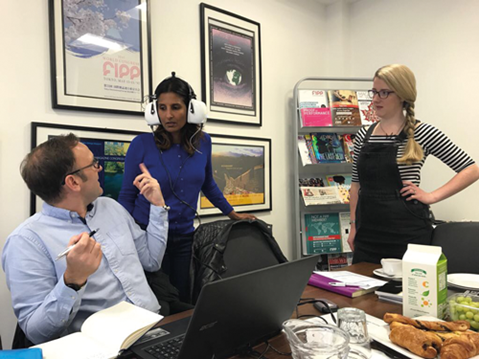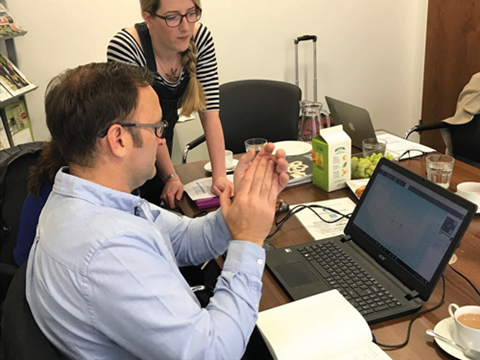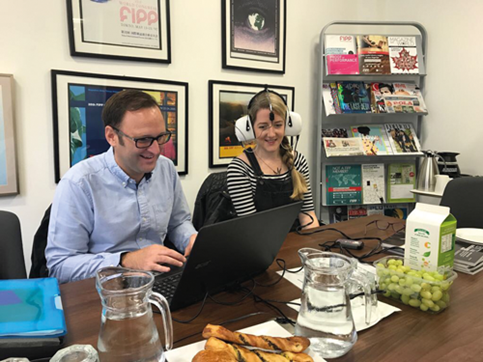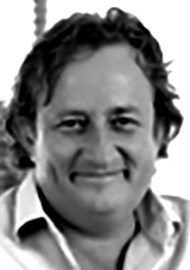The KUDUwaveTM was designed to replace the need for a sound booth and enable truly portable audiometry in almost any environment. ENT & Audiology News’ own Gareth Smith, Priya Carling and Alex Griffiths Brown met in London to put the audiometer to the test, and caught up with the inventor, Dr Dirk Koekemoer and the distributor, Neil Mcintosh to learn more about the device.
Let us start with a confession: I don’t read manuals. There, I said it and I don’t regret it. I want technology to be intuitive, for it to tell me how to use it rather than to have to read a 1000-page manual. And so, in a corner office on a busy street in London, it was with that intuitive game-plan in mind that Alex, Priya and I opened the KUDUwaveTM Audiometry box for an unguided test run.

The first premise of the KUDUwaveTM is to take away the need for a booth when carrying out audiometry. So, first out of the box are some unwieldy looking headphones; it was with some surprise we discovered how light they are! Plugging the headphone set into the laptop was straightforward; this is via two USB ports, with the response button taking up a third port. The unwieldy earcups or Ambi-domesTM (KUDUwaveTM’s name for them) do serve a purpose: they contain sound-level meters, as well as noise isolation. The noise isolation is further enhanced by acoustics seals around the cup and, finally, the tone is delivered to the canal via insert tips, providing three levels of noise reduction.
“I want technology to be intuitive, for it to tell me how to use it.”
The bone conduction (BC) had us a little confused! The BC headband and transducer is attached to the Ambi-domesTM headband. With the large Ambi-domesTM, we couldn’t figure out how to put the BC transducer in a sensible mastoid placement. We looked at the picture on the manual. Okay, so maybe cheating the intuitive strategy slightly, but I’m pretty sure we wouldn’t have spotted the BC placement is in the centre of the forehead without it!

Feeling pretty pleased with ourselves so far, we moved onto the laptop software. The hardware connected to the software without a glitch. The software opened and it was at this point, we really stumbled for the first time. The software version we used was much less intuitive than I had anticipated from the hardware experience. We found a test patient in the system and moved to a testing mode. Having clicked into the test mode, a pop-up box with a very small, greyed-out arrow appeared on the main page prompting you to select the test to move forward to testing – we had to reach for the manual at this point! Once we had found the little arrow, we were away again.
There are plenty of test options to choose from, including automated audiometry, manual audiometry, screening and high frequency audiometer. Once in the test mode, there is a clever talk-forward option, allowing you to speak to the client through the inserts – we found this was needed, given the excellent level of noise protection provided by the Ambi-domesTM. I took control for the first run, with Alex in the test seat. In a quiet side-office, we were able to test Alex down to 10dBHL (oh, to have young ears!) with the noise-monitoring function remaining stable. We then created some noise and found the built-in SLM very effective in monitoring the ambient noise. We managed to crash the software several times and had to close the application down to come out of it. We felt training on the software or software improvements were required.

After we had all had a play, we discussed the application of this device. The KUDUwaveTM comes in three versions – Prime, Plus and Pro – each with further developed features: the Prime has air-conduction screening through to the Pro with high-frequency audiometry. Alex, Priya and I could all see arenas for this device to be used – occupational environments, nursing homes and domestic environments to name a few. We could see some drawbacks: the Ambi-domes really are very large and could prove difficult for use with children and those less mobile. We considered issues around infection control: it was difficult to establish how to effectively clean the inside of the Ambi-domesTM and the tubes for the inserts, or if covers were an option. Inserts present a well-documented challenge in themselves. However, as an alternative to a booth or where a booth cannot go, this innovation provides a sound alternative.
In the post-review analysis, Priya and Alex have taken some time to quiz the UK distributor, Neil Mcintosh, and the inventor, Dr Dirk Koekemoer further about this product.
A few words from the UK distributor…
Up until now, your focus as a company seems to be around noise protection/in ear monitoring systems. When did you become aware of this technology and what made you decide to expand to screening/diagnostic equipment?
We did originally have some business interests in South Africa and, as one of the directors is from Cape Town, we regularly kept an eye on the audiology markets there. It was by chance that I stumbled upon the KUDUwaveTM.
When I investigated the device, I was impressed enough to make direct contact with Grant Slabbert at eMoyo and we struck a deal. It transpired that we were just in the right place at the right time as the CE accreditation had just come through for the European market and eMoyo had not yet decided on a marketing strategy.
Where do you feel the main application of the KUDUwaveTM will be?
Although predominately CluisTROM dealt with custom hearing protection, we also offered audiometric tests and sound surveys, so lugging around a ‘portable’ audiometer or rolling up at a work site and looking for a parking space for a soundproof van was something we had first-hand knowledge of. When we discussed it in house, we could find no reason for not looking more closely in to bringing the Kudu to the UK. Now we are using them in our three hearing aid dispensary clinics as well. I have been in many situations where tests were carried out in the back room of opticians or in a room kitted out for a completely different service so I knew that even the largest retailers lacked the space for a booth but were aware of the issues in not having one. To me, the KUDUwaveTM was a perfect solution. It was fiddly at first without a doubt (especially the BC headband, which I will assume you agree with!) but after a week or two it became second nature and now we realise it’s actually easier to use than a booth with inserts and/or headphones.
“Being able to conduct gold standard hearing tests practically anywhere (along with tympanometry) from a simple set of headphones makes it unlike anything else out there.”
How can we find out more?
Although the device offers great benefit in any domiciliary situation, I still think that the KUDUwaveTM stands out most on its own in the occupational health market. Being able to conduct gold standard hearing tests practically anywhere (along with tympanometry) from a simple set of headphones makes it unlike anything else out there. With the Pro version testing up to 16k (used in ototoxicity testing) we are hopeful the NHS will take notice but even for occupational health businesses, it’s a brand new service they can offer without the need for premises or the purchase of a van. With the cloud application you can conduct a hearing test with someone on the other side of the world while you sit at home in your PJs – how neat is that?! You can get more info from us at
info@cluistrom.com but even after purchase there are free web seminars and we set aside time to do one-on-one skype classes with new customers so they get hands-on, real assistance.
J Neil Mcintosh Rhad
Why KUDUwaveTM? A discussion with the inventor…
Tell us about the background to developing the concept of the KUDUwaveTM.
Before inventing the KUDUwaveTM, I used to practice as a medical doctor in a private practise. As a doctor, I was so frustrated that I was only able to see a limited amount of patients and that I was limited in my ability as a diagnostician. After I had the horrible experience of missing a brain tumour in a patient, I went on a quest to create technology to help myself and other health practitioners to see more patients through telemedicine and to develop devices to improve my own and others’ ability to diagnose better.
One such machine was an audiometer that could reach places where no other audiometer could go. Less than 5% of patients with hearing loss in most countries receive some kind of hearing healthcare. The KUDUwaveTM was actually the fifth audiometer I developed. The first four were well-designed audiometers, but none of them would have significantly improved the way hearing healthcare was delivered because the sound booth could not be miniaturised. In this quest to develop an audiometer that could go places, I realised that my electronic stethoscope, which I had also developed, was nothing more than an audiometer. This stethoscope monitored the ambient noise for noise cancellation and the idea was born to create the KUDUwaveTM that would be able to block sound well and also monitor the ambient noise.
The first 3D printed KUDUwaveTM was used in practice for two years while the commercial device was created. In this period, the KUDUwaveTM start-up won the premium FNB business plan competition in South Africa. This plan is still being followed and part of this plan is the addition of a tympanometer to the KUDUwaveTM which is something we are finalising at the moment.
Can you give us an idea of where this has been used already and any feedback you have received to date?
The KUDUwaveTM is used in over 25 countries around the globe by audiologists, occupational/industrial health service providers, ENT practices, general practitioners (GPs) and clinics/hospitals alike.
As a South African company, our products are widely distributed within SA and Africa with a very successful programme in MDR-TB (drug-resistant tuberculosis), rolling out ototoxicity monitoring in conjunction with South African National Department of Health, saving thousands from the negative effects of medication-induced hearing loss.
In MDR-TB, a significant benefit is that, by using the KUDUwaveTM instead of a sound booth, a source of cross-contamination has been removed and patients who may be ill or otherwise unable to move, can receive bedside treatment in the hospital or in their home. An additional benefit is that almost any trained staff are able to perform the tests with automated test protocols.
The feedback has been very positive, with many practitioners really enjoying the fact they can provide the same quality of testing offered with traditional equipment but in a small and portable format. Similar comments have been received from patients who prefer booth-free testing.
Audiologists are seeing more patients as they can now travel to their patients’ homes, retirement villages, schools and other such facilities to test on sight.
“In this quest to develop an audiometer that could go places, I realised that my electronic stethoscope, which I had also developed, was nothing more than an audiometer.”
Occupational health companies are also now able to reach many areas traditional equipment could not, and find it easy to scale up or down when needed.
All in all, the KUDUwaveTM has helped its users to provide better access to care and improved customer service to patients. This is something we are very proud of, and that aligns with the eMoyo ethos of ‘healthcare for humanity’ where we have committed to creating the technology to provide access to quality healthcare for the millions in need.
With the addition of a built-in tympanometer, many other new software developments and additional integrations scheduled for 2018, we expect to see the extent of care, reach and quality of service further expanded.
Do you think this has potential for the low to middle income (LMIC) market?
The need for accessible hearing care is prevalent in all markets. The LMIC market is certainly in desperate need of affordable, quality care and the KUDUwaveTM goes a long way to help meet that need.
Audiologists are a rarity in this segment. In our home country, South Africa, there are less than 1000 practising audiologists servicing over 55 million people and we are one of the best equipped and staffed.
With automated testing options available with the KUDUwaveTM, we enable nurses, doctors and trained technicians to take on hearing care services in their own practices and automatically refer to audiologists, GPs or ENTs for treatment. This reduces referral loops and fills audiology practice waiting rooms with patients who need hearing aids, rather than referring them on to a GP for antibiotics.
These benefits also translate well to other markets. Hearing care is, by and large, underserved worldwide. By offering the same quality of care as traditional equipment at a lower cost, and in a portable format, users are able to set up new practices, grow a practice, expand their service offering (mobile) or introduce new services such as quality in-store testing for pharmacy groups and more.
www.kuduwave.com
‘Spotlight on Innovation’ is an informative section to provide insight and discussion on recent advances in technology and research and does not imply endorsement by ENT and Audiology News.








